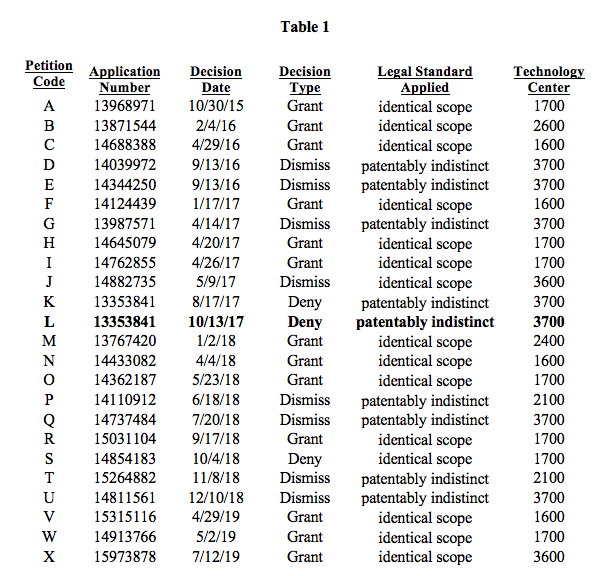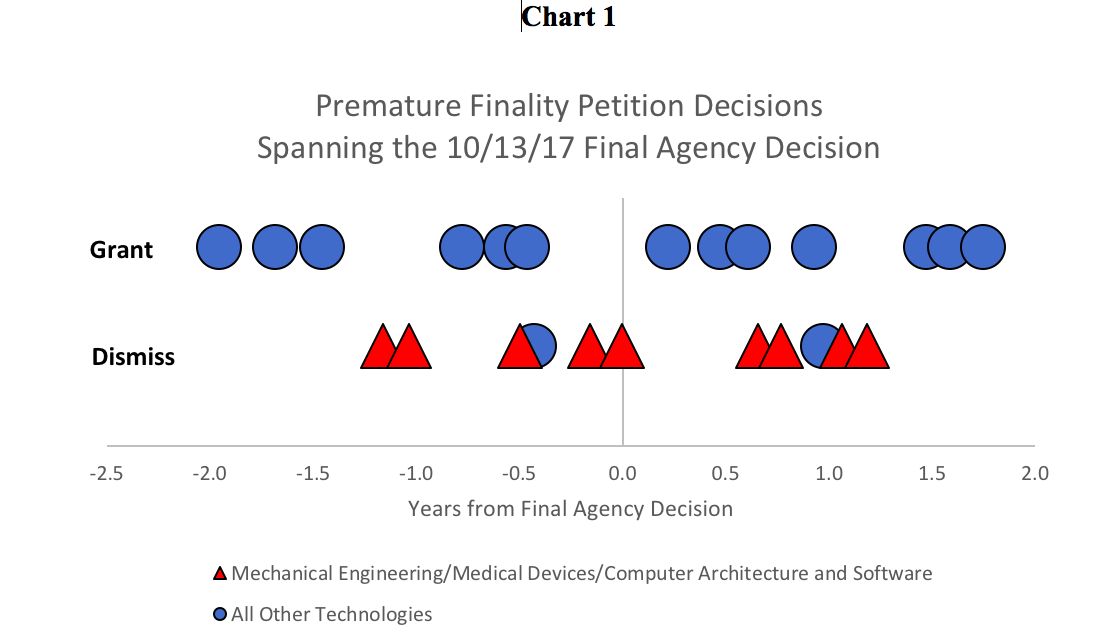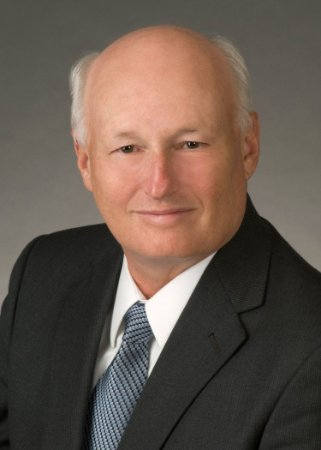“Codifying two alternative first action final rejection standards in the June 2020 MPEP permits all patent examiners to arbitrarily impose FAFRs on substantively amended claims, if they so wish.”
 The USPTO recently revised Manual of Patent Examination Procedure (MPEP) Section 706.07(b) to retroactively impose a first action final rejection (FAFR) policy that significantly reduces patent applicants’ options (MPEP, E9R10.2019. Fed. Reg. Vol. 85, No. 133 page 41,571). In Part 1 of this two-part series, we analyzed the final agency decision provided by the USPTO as basis for the FAFR policy change. Here, in Part II, we analyze petition decisions relating to FAFRs made on amended claims filed in continuing applications.
The USPTO recently revised Manual of Patent Examination Procedure (MPEP) Section 706.07(b) to retroactively impose a first action final rejection (FAFR) policy that significantly reduces patent applicants’ options (MPEP, E9R10.2019. Fed. Reg. Vol. 85, No. 133 page 41,571). In Part 1 of this two-part series, we analyzed the final agency decision provided by the USPTO as basis for the FAFR policy change. Here, in Part II, we analyze petition decisions relating to FAFRs made on amended claims filed in continuing applications.
We discovered, when determining the propriety of a FAFR, the USPTO has been comparing whether claims are drawn to same invention using two separate legal standards: identical scope or patentably indistinct. The majority of the patent corps apply the 1969 legal standard which limits FAFR to claims of identical scope as previously examined. The results of our analysis indicated the new patentably indistinct standard authorizing FAFR on substantially amended claims originated in one Technology Center (TC), was upheld by the FA Decision (defined below), and then adopted by another TC in 2018. Codifying two alternative FAFR standards in the June 2020 MPEP permits all patent examiners to arbitrarily impose FAFRs on substantively amended claims, if they so wish.
Expansion of FAFR Policy Attributed to a Final Agency Petition Decision
As discussed in Part 1, the USPTO expanded their authorization to make FAFRs on amended claims filed in continuing applications, based on the 2017 final agency petition decision (FA Decision) in patent application 13/353,841. The FA decision relies on the Molins PLC v. Quigg, (D.D.C. 1987) and (Fed. Cir. 1988) decisions, dismissed for mootness and lack of ripeness, and the In re Bogese decision, 22 USPQ2d 1821, 1824-26 (Comm’r Pat 1992), involving five serial continuations filed without response or amendment. The FA Decision alludes to, but does not identity, other “past first final actions decisions” relied upon when imposing the FAFR policy change.
Better Access and Searchability for USPTO Patent Petition Decisions
Historically, it has been difficult for patent practitioners to obtain access to relevant USPTO petition decisions. While USPTO final agency petition decisions are made public, they are only available in their extremely hard-to-find FOIA Reading Room and in Public PAIR, if you know the patent application number. Moreover, the rare decisions pertaining to premature final rejections have been indistinguishably deposited under the catch-all “Other” group which contains several hundred miscellaneous decisions in non-searchable and uncategorized PDF documents. Locating decisions pertaining to premature final rejections amongst these hundreds of decisions is like finding a needle-in-a-haystack. For all intents and purposes, the USPTO’s final agency petition decisions have heretofore been practically unavailable to the public.
A recently launched database hosted by one of the authors of this article makes it possible to easily and efficiently access and search patent petition documents, including the decisions highlighted in this article. Petition.ai is the first comprehensive searchable database of USPTO patent petition documents. The database includes 500,000 petition documents from 200,000 patent applications filed since 2013 and the USPTO published final agency decisions.
Petition Decisions Directed to FAFRs of Amended Claims
A search query of the database using the keywords “first action final” or “706.07(b)” quickly identified many decisions pertaining to premature final Office actions. The queried petitions were reviewed for the specific fact pattern: FAFR of amended claims filed with requests for continued examination (RCEs) or continuation applications (CONs).
We identified 23 additional decisions mailed between 2015-2019 and signed by 16 different TC personnel. Including the FA Decision, 22 petitions were directed to FAFRs following an RCE while two petitions pertained to FAFRs in CONs.
The resulting decisions were carefully reviewed to determine the meaning intended for the phrase same invention, thereby discerning which legal standard – identical scope or patentably indistinct – was applied to assess the propriety of the FAFR. The resulting decisions were sorted by TC, decision date, decision type and legal standard applied include a mix of grants, dismissals and denials which originated from seven TCs. The FA Decision, coded as Decision L, is the only final agency decision identified. Any other “first final action decisions” alluded to in the FA Decision escaped our discovery.

Analyzing the 24 FAFR Decisions
From this survey, 15/24 (62.5%) of the petitions were decided by defining same invention as the identical scope legal standard while 9/24 of the petitions (37.5%) were decided by defining same invention as the recently codified patentably indistinct legal standard.
- When the identical scope standard was applied, practitioners experienced an 87% (13/15) grant rate. Representative rationale: “the claims were amended (i.e., narrowed) … the claims are not drawn to the same invention.” See Decision N. De minimis amendments resulted in dismissals. See Decision J (amended “attachable” to “attached”) and Decision S (added one dependent claim).
- Remarkably, 0% (0/9) of the decisions were granted when the patentably indistinct standard was applied. Representative rationale: the claims were “directed to the same invention claimed previously, even though claim 1 amended the images to be ‘thumbnail images,’ and included the additional limitation of ‘wherein resolutions of the received thumbnail images are lower than resolutions of the plurality of the medical images…’ while removing limitations…” (Emphasis added) See Decision T.
Current petition grant rates help practitioners make informed decisions when considering whether to file a petition. The USPTO posted a 41-44% 12-month rolling average grant rate for petitions related to all types of premature final rejections. The 24 petitions in this survey are granted at a higher rate (54%), however grant rates vary dramatically depending on the legal standard applied – 87% using identical scope and 0% for patentably indistinct.
TCs Exclusively Apply One FAFR Legal Standard
We identified a clear demarcation between the legal standards applied by TCs, resulting in vastly divergent FAFR practices depending on Applicant’s technology- and industry-sectors. Petitions filed in TC3700 (Mechanical Engineering, Manufacturing, Gaming and Medical Devices/Processes) and TC2100 (Computer Architecture and Software) were exclusively decided based upon the patentably indistinct standard and experienced a 0% grant rate. Petitions filed in all the other technology sectors were decided using the identical scope standard and enjoyed an 87% grant rate. Applicants for these other technology sectors were permitted to receive non-final Office actions on amended claims filed with a RCE or CON. No petition data was found for TC2800 (Semiconductors/Memory, Circuits/Measuring and Testing, Optics/Photocopying, Printing/Measuring and Testing), suggesting that TC2800 examiners made no improper FAFRs or that their practitioners filed no petitions to request withdraw of an improper FAFR.
Chart 1 clearly depicts that the different FAFR outcomes before and after the sole FA Decision are based on the Applicant’s technology- and industry-sector.

FAFR Legal Standard Appears to be Technology Center, Not Group Director, Dependent
Interestingly, the legal standard used to evaluate the petitions seemingly was tied to the Applicant’s industry sectors, not to individual Group Directors. During the time period surveyed, TC1600 (identical scope) and TC3700 (patentably indistinct) swapped group directors.
In April 2016, as a TC1600 Group Director, Mr. Jerry Lorengo applied the identical scope legal standard to grant Petition C. Yet, in December 2018, now as a TC 3700 Group Director, Mr. Lorengo applied the patentably indistinct standard to dismiss Petition U.
In April 2017, as a TC 3700 Group Director, Mr. Andrew Wang, or his designee, applied the patentably indistinct legal standard to dismiss Petition G. Yet, in April 2018, now as a TC1600 Group Director, Mr. Wang applied the identical scope standard to grant Petition N.
The Majority of Examiners Work in TCs that Applied the Identical Scope Legal Standard
Taking into account examining corps staffing as of February 2020 and TC subject matter, Chart 2 shows that most examiners work in TCs where the identical scope standard is applied.

Prior to the FA Decision, only 15% of the patent corps, TC3700, applied the patentably indistinct standard. In 2018, a further 11% of the patent corps, TC2100, began to apply the patentably indistinct standard in Decisions P and T, parroting language from the FA Decision. As a result, only one quarter of examiners work in TCs which apply the new patentably indistinct standard. The other TCs did not apply this rationale when deciding FAFR petitions. As such, the June 2020 change to Section 706.07(b) represents a practice change to at least 59% and possibly 74% of the patent corps.
One explanation for Chart 1’s finding is USPTO personnel, like the public, were not informed of the FA Decision or were not given advance notice of the June 2020 changes to Section 706.07(b). Conversely, USPTO personnel who authored the FA Decision and then modified Section 706.07(b) may be operating in a vacuum, unaware that the most TC personnel routinely apply the identical scope standard to grant FAFR petitions. Selection bias may play a role since Applicants only file renewed petitions when their initial petition is dismissed/denied.
Will Serial FAFRs Become Commonplace?
In addition to Decision L’s precedent upholding two serial FAFRs, emboldened by Decision D, a dismissal, that examiner made a second FAFR on amended claims submitted with the 2018 RCE.
In May 2019, a TC1700 Group Director applied the identical scope legal standard to overturn an improper FAFR in Decision W. Following the June 2020 policy change, that examiner made a second FAFR on amended claims filed with the August 2020 RCE.
As forewarned in a recent LAW360 article, early signs suggest that the USPTO’s new FAFR policy has the potential to constructively abolish non-final Office actions during continued examination. The authors will monitor upcoming petition decisions to determine how the June 2020 policy change alters FAFR practice.
The USPTO Should Adopt a Compact Prosecution Policy
As previously urged, final rejections and the attendant after final practice are anachronisms that need to be abolished in favor of a modernized compact prosecution regime where every amendment is entered as a matter of right with applicant’s response to every third office action to be accompanied by a RCE request and fee. (See In Order To Form A More Perfect Patent Examination System—It Is Time To Update Compact Prosecution to Compact Prosecution 2.0, posted September 24, 2013 on the IPO Law Journal-Patent Section web page). The adoption of such a policy will save examiners and applicants resources (time, effort, and money) that are now used in a futile manner. The best example of this futility is the USPTO’s new FAFR policy, based on one obscure FA decision, and retroactively implemented without wide notice and with no opportunity for stakeholders to prepare or comment. That the USPTO used its resources to implement this new policy instead of modernizing compact prosecution is not understood. Applicants should be able to expect better treatment from an agency funded by their user fees.
Image rights acquired by AdobeStock

![[IPWatchdog Logo]](https://ipwatchdog.com/wp-content/themes/IPWatchdog%20-%202023/assets/images/temp/logo-small@2x.png)



![[Advertisement]](https://ipwatchdog.com/wp-content/uploads/2024/04/Artificial-Intelligence-2024-REPLAY-sidebar-700x500-corrected.jpg)
![[Advertisement]](https://ipwatchdog.com/wp-content/uploads/2024/04/Patent-Litigation-Masters-2024-sidebar-700x500-1.jpg)

![[Advertisement]](https://ipwatchdog.com/wp-content/uploads/2021/12/WEBINAR-336-x-280-px.png)
![[Advertisement]](https://ipwatchdog.com/wp-content/uploads/2021/12/2021-Patent-Practice-on-Demand-recorded-Feb-2021-336-x-280.jpg)
![[Advertisement]](https://ipwatchdog.com/wp-content/uploads/2021/12/Ad-4-The-Invent-Patent-System™.png)






Join the Discussion
8 comments so far.
ipguy
September 30, 2020 07:09 pm@7
I did not take your post as challenging my assertion. Sorry if I wasn’t clear that I was in agreement with you. In any event, with or without an AFCP 2.0 request, while it may have previously just been good practice to file an After Final within two months of the Final Office Action’s mailing date to get an Advisory Action, it now seems almost mandatory in order to avoid a First Action Final.
Anon
September 29, 2020 07:23 amThanks ipguy,
I was not challenging your 90% assertion; rather, feeding on that low 10% usefulness, I intended to draw scrutiny to the “policy-making” that would now make it more necessary to engage in that 10% return action on nothing more than a whim of a bureaucrat, rather than any underlying merits of a process.
ipguy
September 29, 2020 04:15 am@5
Like I said, 9/10 times I’ve submitted an AFCP 2.0 request, it’s been denied, and it seems that at least half of those cases wind up getting a Notice of Allowance after I file the RCE. Does the USPTO even collect data for statistics about how many times a Notice of Allowance immediately follows an RCE?
In any event, after the AFCP 2.0 is denied (for the usual BS reasons), I get the Advisory Action giving the usual BS reasons.
Anon
September 28, 2020 01:32 pmipguy,
On the whole, I quite agree with you and that it may be few and far between the instances in which a reply after final does not take advantage of the ‘free bite’ that an Advisory Action may provide.
Unfortunately, I have actually seen an increase of late as to cases that fit that profile.
That is, in particular, when you know that the examiner has never permitted an AFCP matter to proceed, and that the examiner is known to always regurgitate his final (regardless of arguments or combinations of arguments and amendments).
Up until this point, it simply made sense (and cents) in those limited cases to proceed straight to an RCE without the cost and timing of a worthless round of prosecution.
Which does make me wonder about this “policy change.”
Does this have substantive effects, or can it genuinely be classified as purely procedural?
ipguy
September 28, 2020 12:15 pm@2
With one or two exceptions, it’s been my practice to submit an After Final reply within two months of the mailing date of the Final Office Action to get an Advisory Action. I saw the value of an Advisory Action when I was an Examiner, and my early mentors also believed in the important of Advisory Actions. In recent years, I’ve done it to take advantage of the AFCP 2.0 (denied 9/10 times from what seems to be an abundance of laziness by the Examiner). I don’t understand why, as a matter of practice, someone would not try to obtain an Advisory Action from the Examiner.
Anon
September 25, 2020 04:06 pmDavid,
Are you really that puzzled?
Were you not around during the Dudas era? Do you not recognize that there remains internal vestiges that clearly are if the “in NO vation” variety (as shown often on this blog per particular art units)?
I do hope that your words were for mere ‘color’ effect and not in earnest.
David Easwaran
September 25, 2020 11:44 amThis is great content, thanks!
The lesson seems to be that it is more prudent than ever to activate the Advisory Action safe harbor before filing an RCE, at least in TCs 2100 and 3700. It is good, I suppose, that we can protect ourselves, but I am a bit puzzled about why the PTO would encourage this behavior.
Pro Say
September 25, 2020 11:24 amSuperb work on a critically important aspect of patenting — thank you all.
I trust that Patent Office leadership will look into this.